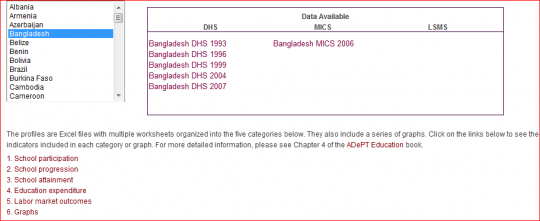Are we effective in presenting education data to help tackle the real issues that developing countries are facing? The education community continues to be puzzled by two realities: (1) crucial data is often not available and (2) available data is often hard to digest.
Last year, when I attended a high stakes conference in Washington, D.C. discussing learning, the audience was shocked when a speaker claimed that major databases did not include indicators of learning from the developing world. Nevertheless, in the era of Open Data, making information available and accessible is not sufficient. How can available data provide insights on achieving the Millennium Development Goals – beyond just tracking and monitoring?
In order to help countries meet the Learning for All targets we need systematic, comprehensive, integrated, and well-presented data. Free and open access to education data can pinpoint gaps and bottlenecks in the education system, and inform policy changes to ensure all children can go to school and learn. Data can tell stories and, in many cases, the use of data tools has helped solve development challenges.
For those of us working on education, data can help measure and monitor learning outcomes. We know that 250 million are unable to read, write and do basic math, despite having spent three or more years in school.
The World Bank’s revamped EdStats website -- our premier one-stop shop for education data -- makes more data available and helps users more easily digest it. EdStats is the first education statistics portal to feature all available education indicators (enriched with learning data) under one platform.
EdStats allows policymakers to identify issues, gaps, successes, and make comparisons with other countries on best practices. It helps answer questions such as:
What are the main issues and obstacles in relation to basic education indicators in a country?
Is there an improvement in education quality in Latin America?
Where are the World Bank’s education operations in the Middle East and North Africa region?
How do teachers’ policies compare across countries?
Can I get examples of education interventions where impact has been systematically evaluated?
Using the new features in EdStats, policymakers can answer similar questions and identify issues, gaps, successes, and make comparisons with other countries on best practices. For example, with EdStats dashboards (using Tableau technology and other visualization tools) you can conduct diagnostics related to the education system and its outcomes in a given country. Here are some examples:
Where does a country stand in terms of learning outcomes from major international and regional assessments (including PISA, TIMSS, PIRLS, PIAAC, LLECE, SAQMEC, PASEC)?
We are also thrilled to announce the addition of Early Grade Reading Assessment data, thanks to our partnership with the U.S. Agency for International Development (USAID).
Where are the inequalities among different groups in the country?
Where does one get access to policy data from the World Bank’s SABER flagship initiative ?
The portal also offers education information from rich and sophisticated household surveys:
The Edstats portal provides easy access to World Bank’s education projects for more information on project components and activities around the world. You can also view results of impact evaluations of selected education interventions.
In developing EdStats, we’ve been fortunate to work with UNESCO’s Institute for Statistics (our main source of general education statistics), UNICEF (for the MICS data), USAID (for Early Grade Data and DHS), Education Sector Board, Edstats team, Data Group, and the SABER team at the World Bank. We hope the portal represents a substantial advancement in access and use of big data in education.
Please visit the site and let us know what you think. I look forward to your suggestions and feedback on areas of improvement. Partnerships are crucial in this area. Let’s do it together.
Follow the World Bank education team on Twitter: @WBG_Education
Related
EdStats
SABER: Systems Approach to Better Education Results







Join the Conversation